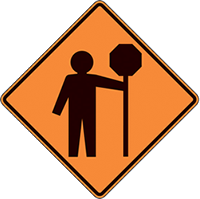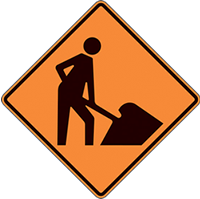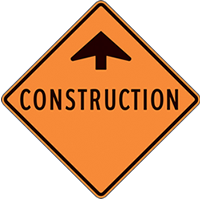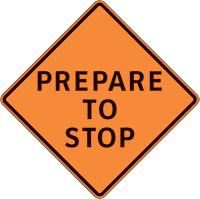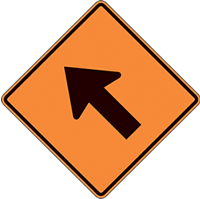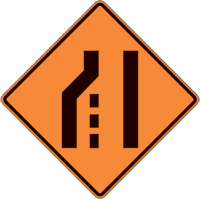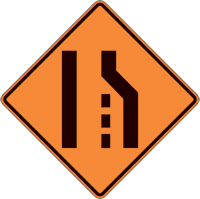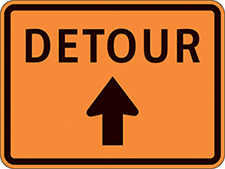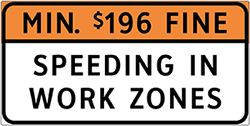
For drivers
You have a role to play in keeping workers and yourself safe when you drive through work zones, often referred to as cone zones. The law requires you to pay attention, follow signs and instructions, and give workers space. Use our resources to learn more about the legal requirements and best safety practices for driving in work zones.
Work zones are risky for workers and drivers
Think about the workplace you go to every day. Now, imagine cars and trucks whizzing by within just a few metres of you. That’s how vulnerable roadside workers are. Sometimes, orange cones are the only things separating their work site from moving vehicles weighing several tonnes.
How you drive in work zones can be the difference between workers staying safe on the job, or suffering an injury or being killed. Going too fast, or driving distracted or aggressively, can cause rear-end collisions and other crashes. And, if you’re not paying attention, you could hit or be hit by vehicles and equipment working in the zone.
According to WorkSafeBC statistics, 9 roadside workers were hit by a vehicle and killed in BC from 2014 through 2023. Another 251 people were injured seriously enough to miss work. Drivers and their passengers were also hurt.
Every worker is someone’s parent, child, friend, neighbour, or co-worker.
Work zone driving laws
Some roadside work zones use signs, flag persons, and cones to let drivers know where they are. Others use a vehicle with red, blue, amber, or white lights flashing.
When you approach and pass through one of these zones, you have specific legal responsibilities. The rules apply even if you can’t see the workers on site.
Wherever there’s road construction, repairs, or marking on BC highways, the Motor Vehicle Act requires drivers approaching and driving through these work zones to:
- Slow down and drive with care
- Pay attention and leave your phone alone
- Obey road signs, traffic control devices, and traffic control people
Devices can include cones, barrels, barriers, and signs that indicate changes in the road layout such as detours, lane shifts, speed adjustments, and road closures.
Signs are usually placed well before the work zone to give you ample time to adjust your driving.
Flag persons have the authority to stop or slow traffic, and direct it through or around a work zone. You need to comply with a flag person’s instructions just as you would with any other traffic signal, like a red light or stop sign.
It’s a good safety practice to reduce your speed to 40 km/h in areas where the usual speed limit is less than 80 km/h. When usual limits are higher, reduce your speed to 70 km/h.
Another best practice is to leave as much room as possible between your vehicle. Move over to another lane if it’s safe to do so, and stop at least a car length in front of any flag person.
BC also has a Slow Down, Move Over law. It applies whenever you approach vehicles with red, blue, or amber lights flashing. These vehicles may include:
- Emergency and enforcement personnel (RCMP, police, sheriff, firefighters, paramedics, Commercial Vehicle Safety and Enforcement, etc.)
- Armed Forces
- Some buses
- Department of Fisheries
- Tow trucks
- Pilot cars
- Oversize vehicle or vehicles used to transport oversized loads
- Conservation officer and park ranger
- Canadian Border Services
- Snow removal or spreading equipment
The Slow Down, Move Over law requires drivers to reduce speed and move their vehicle to the left to increase the space between their vehicle and the workers and/or the emergency vehicle.
In these work zones, watch for signs showing reduced speed limits. If there aren’t any, adjust your speed as follows:
| Posted speed limit | Slow in work zone to |
| 80 km/h or higher | 70 km/h or less |
| Less than 80 km/h | 40 km/h or less |
Follow these best practices if you encounter a vehicle with flashing lights that’s stopped on your side of the road:
- Slow down and get ready to give the people in that work zone the space they need.
- Do a shoulder check and signal as you prepare to go around the vehicle.
- Move your vehicle to the left so there’s at least 1.5 metres between you and the emergency vehicle/worker.
- Move your vehicle back into the proper lane as soon as you are safely past the emergency vehicle.
If there’s no oncoming traffic and it’s safe to do so, you may need to temporarily cross the centreline to provide a safe distance. If there is oncoming traffic, you may need to slow down or come to a stop until you can proceed safely.
Work zone driving penalties
The typical fines in BC for work zone violations include:
- Failing to follow the Slow Down, Move Over Law: $173 and 3 points
- Using an electronic device while driving: $368
- Speeding: $196 and up
- Disobeying a traffic control device: $121
- Disobeying a traffic control person: $196
How to recognize a roadside work zone
A roadside work zone is any area next to a road where a worker may be exposed to the hazards of moving vehicles. It can be fixed in one place, such as a construction site or the area around a tow truck picking up a stranded vehicle. Or it can be mobile work, such as mowing, line painting, or garbage and recycling collection.
These types of work sites involve hundreds of activities. Tens of thousands of BC residents work in these zones every day, including municipal workers, landscapers, traffic control persons, tow truck drivers, road construction and maintenance workers, telecommunications and utility workers, and emergency and enforcement personnel.
Every one of them deserves to get home safe and healthy. You and your passengers do too.
You can often recognize a work zone by its bright orange cones, signs, devices, and traffic control persons. But not all work zones use cones. They may use barriers like barrels and fences, rumble strips, electronic signs, and reflectors instead.
And not all roadside workers are protected by work zone barriers. For example, paramedics treat patients who have been hurt on or near roads. Without any protective barriers, they need drivers to give them as much space and consideration as possible.
A work zone extends from the first traffic control device you can see to the last one you can see. It can be hundreds of metres long, or only extend several metres around a work vehicle parked at the roadside. It may be in place for weeks or just for a few hours. In all cases, you’re responsible for obeying all driving instructions and sharing the road safely.
Watch for automated flagger assistance devices (AFADs)
You may encounter an automated flagger assistance device (AFAD) on BC roadways. They’re becoming more common at work zones because they help keep you and roadside workers safe while effectively managing traffic.
AFADs are portable equipment with highly visible signs that are remotely operated by traffic control persons. They have red and yellow traffic lights and a gate arm that moves up and down with a fluorescent orange or red flag. You may see them on 2-lane, 2-way roads, and on multi-lane roads that have been reduced to one lane.
The light on an AFAD tells you what to do:
- Flashing yellow: Drive with care.
- Solid yellow: Prepare to stop.
- A red light: Stop.
Stop at least one car length from the AFAD when the arm is down and the light is either solid yellow or red. Don’t proceed even if there is no oncoming traffic.
Drive ahead only when the light switches to flashing yellow and the gate arm is fully raised.
Work zone driving tips
When you approach a work zone, drive like one of your loved ones or a close friend works there. There’s a lot going on around you: shifting traffic patterns, uneven or narrow road surfaces, sudden stops, lane changes, and traffic control devices and persons.
Follow work zone driving laws, respect roadside workers, and be patient. Brief delays are sometimes necessary to help keep you, your passengers, and the workers safe.
Here are additional tips for driving in work zones:
Check your planned route before you go to find out if you’ll pass through any work zones. If you will, change your route if possible or expect delays and allow for extra travel time.
Visit DriveBC and use its Plan Your Route tool or Conditions & Events page. Both will alert you to work zones and various driving hazards. You can also listen to traffic reports or use GPS before and during your drive.
You may need to merge with another lane of traffic as you approach a work zone. If so, merging like a zipper will bring vehicles in both lanes together smoothly and get you through the merge faster.
When you see a merge sign and need to change lanes, don’t do it abruptly. Look for an opportunity to change lanes smoothly and safely, and move over early so you have more time to safely complete the merge. If you wait too long, you could hit a traffic control device or person, or end up inside the work zone.
Never enter the area behind barriers, cones, or any other traffic control devices.
Work zones can change daily, so anticipate new traffic patterns. Watch for other drivers and road users who may not be paying attention. Expect delays, especially during peak travel times.
Don’t tailgate. Allow extra space between your vehicle and the one in front of you. This gives you time to react if you need to stop suddenly, or if weather and road conditions make it more difficult to stop. Watch for large vehicles and avoid sudden lane changes in front of trucks or buses, which can be slower to respond.
Slow down even if you don’t see anyone working. Workers may not always be visible and they may appear suddenly. Dust from road construction can also obscure your vision.
Look out for potholes, uneven pavement, and construction debris.
Like you, roadside workers have a job to do. Their work helps you.
For example, road maintenance and construction crews help keep highways safe for your travel. Traffic control persons help keep you safe by managing traffic flow. Municipal workers help ensure your local services function.
You can help them by:
- Making eye contact
- Stopping at least a car length away from a traffic control person
- Keeping your cool and being patient
A lot of work zones in BC operate at night and during bad weather. These times can be especially dangerous for workers and drivers. Visibility can be poor, and drivers may feel more fatigued due to stressful driving conditions.
When ice, cold, rain, or fog are present, make sure you slow down, drive for the conditions, and use low-beam headlights to improve vision at night. Also be aware of the signs of driver fatigue.
Roadside work zone speed limits can be in effect even when workers aren’t present. This is to help protect you from hazards associated with a road under construction. Hazards can include uneven road surfaces or drop-offs, narrow lanes, changes in alignment, reduced sight distances, and lack of shoulders or lane markings.
If you see work zone signs and devices covered or turned off and driving conditions are good, you can proceed at the regular posted speed limit.
Test your knowledge by taking our Driving in a Work Zone Quiz.
Work zone tips for commercial drivers
Large blind spots, long stopping distances, and narrow lanes make work zones particularly challenging for large trucks and buses.
As you approach lane closures, check your blind spots and move into the open lane as soon as possible. Help prevent rear-end crashes by obeying speed limits, avoiding distractions, and maintaining extra space between your vehicle and the one in front of you.
If you need to suddenly slow down or stop, use your emergency flashers to alert drivers behind you.
Learn more about driving for work and winter driving for commercial carriers.
Understanding work zone signs
Work zone signs warn drivers of upcoming roadside sites and changes in traffic patterns. Drivers need to pay attention to the warnings and follow instructions on the signs and readerboards. Here’s what the signs tell you.
|
Traffic control person ahead You’re approaching a work zone where you’ll be directed by a traffic control person. Start slowing down, watch for the traffic control person and prepare to follow their instructions. |
|
|
Crew working ahead (for short duration work zones) Workers are on the road. Watch carefully and avoid coming close to them. |
|
|
Construction ahead (for longer duration work zone) You’re entering a construction zone. Drive with extra caution and be prepared for changes in the speed limit. |
|
|
Prepare to stop You may be required to stop ahead. Slow down and watch for traffic control persons or devices. Be patient. |
|
|
Single lane traffic You’re approaching a section of single lane traffic. Slow down and watch for traffic control. |
|
|
Lane closure The lane is closed ahead. Adjust your speed to merge with or shift into the lane indicated by the arrow. |
|
|
Lane closed ahead The left or right lane is closed ahead on a road that has 2 or more lanes travelling in the same direction. Slow down, begin to merge into the lanes that remain open, allow other vehicles to merge safely, and be prepared to stop. |
|
|
Detour ahead Traffic is temporarily detoured due to road work ahead. |
|
|
Minimum $196 fine The penalty you face for exceeding the work zone speed limit. |
|
